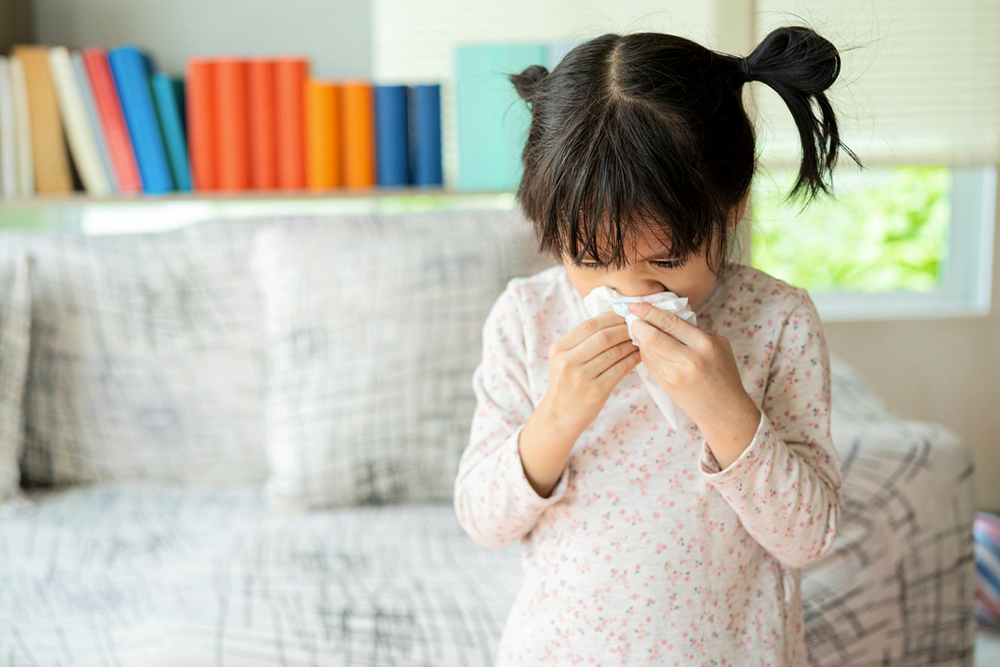
28 Oct Understanding and Managing Your Child’s Allergies
As a parent, witnessing your child struggle with allergies can be both worrisome and stressful. Allergies occur when your child’s immune system overreacts to certain substances, causing symptoms that can affect their daily activities and overall well-being. Let’s look at some of the common childhood allergies, when they typically develop, and effective natural remedies for little ones. By understanding these challenges, you can better support your child and help them navigate their allergies with ease.
When Do Children Develop Allergies?
Allergies usually make their first appearance in childhood, with many kids showing symptoms by around age three. However, it’s not uncommon for some allergies to develop later as children encounter different allergens. Several factors come into play, including genetics, environmental influences, and when certain foods are introduced. All of these can affect whether or not a child develops allergies as they grow.
Common Allergies To Look Out For
Hay Fever: Also known as allergic rhinitis, hay fever is triggered by pollen from trees, grasses, and weeds. Children suffering from hay fever may experience symptoms like sneezing, a runny nose, and itchy, watery eyes. Symptoms can increase during the spring and summer months when pollen counts rise. As a parent, it’s important to recognise these symptoms early and minimise exposure by keeping windows closed during high pollen days and encouraging your little one to wash their hands and faces after playing outside.
Dust and Dust Mites: Dust mites are microscopic creatures that thrive in warm, humid environments and are commonly found in bedding, carpets, and upholstered furniture. They feed on dead skin cells and can populate in homes with high humidity. For sensitive children, exposure to dust mite droppings can trigger allergic reactions, leading to symptoms like sneezing, nasal congestion, and itchy skin. Maintaining a regular cleaning routine is essential as it will help reduce allergen levels in your home.
Food Allergies: Food allergies can develop in early childhood, with common culprits including lactose (found in dairy products) and gluten (found in wheat and other grains). Symptoms can vary quite a bit; mild reactions might involve digestive issues like stomach aches and gas, while more serious reactions could lead to hives or even anaphylaxis, which can be life-threatening. It’s important to keep a close eye on your child’s reactions to certain foods and to consult a healthcare professional for proper testing and symptom management. Taking these proactive steps can help ensure that children with food allergies remain safe and healthy while enjoying a varied diet.
Tips for Managing Allergies Naturally
Know Their Triggers: Keeping a symptom diary can be really helpful to understand what’s causing your child’s allergies. Write down when symptoms pop up, along with the time of year, activities, and places you’ve been. This can help you spot triggers like hay fever or pet dander.
A Healthy Home: Regular cleaning is key to reducing indoor allergens. Use hypoallergenic bedding and wash linens often in hot water to get rid of dust mites. A vacuum with a HEPA filter can effectively capture dust and pet dander, and having an air purifier in your child’s room can improve air quality, making it easier for them to breathe.
Natural Remedies: These natural remedies offer a gentle, holistic way to manage your child’s allergies and ease symptoms.
- Coconut Oil: A little coconut oil inside your child’s nostrils can help trap dust and allergens, keeping them from entering their respiratory system. This simple remedy can be a gentle way to ease congestion, especially during allergy season.
- Apple Cider Vinegar: Mixing apple cider vinegar in water (and adding honey for older kids) can support digestion and may help cut down on mucus production, making it easier for kids to breathe. It’s particularly helpful for tackling hay fever symptoms.
- Oatmeal Baths: If your child has skin allergies or irritations, an oatmeal bath can provide great relief from itching. Just grind oats into a fine powder and add it to a warm bath for a soothing soak that can calm irritated skin.
- Essential Oils: Diffusing calming essential oils like lavender or chamomile in your child’s room can create a relaxing space. Just make sure your child isn’t sensitive to any of these oils.
Consider Dietary Adjustments: If your child has food allergies, work with a healthcare professional to create a balanced diet that avoids allergens. Include a variety of colourful fruits and vegetables rich in vitamins and antioxidants, which can boost their overall health and help support their immune system.
Hydration: Encourage your child to drink plenty of water, especially during allergy season. Staying well-hydrated helps thin mucus and keeps their airways clear, making it easier for them to breathe and feel comfortable throughout the day.
Supporting Your Child Through Allergies
Navigating allergies can be challenging for both you and your child. By understanding common allergies and recognizing symptoms early, you can create a supportive home environment. Implementing simple lifestyle changes and exploring natural remedies can help your child thrive despite their allergies.



No Comments